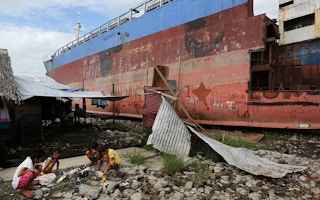From hurricane-ravaged Haiti to drought-parched southern Africa, the world’s poorest countries are battling increasingly extreme weather being thrown their way as the planet warms. But the aid on offer globally to help them cope is still a pittance compared with what they need, experts say.
When ministers gather at the two-week U.N. climate change talks in Morocco, which started on Monday, one of their focuses will be finding ways to boost funding for developing countries to adapt to the effects of climate change.
Ahead of the Marrakesh conference, a grouping of the poorest countries warned they are especially vulnerable, with rising seas, worsening drought and floods, and the spread of tropical diseases threatening public health and food security.
“We lack the resources and capacity to adequately protect our communities from the devastating impacts of climate change,” said the group’s chair, Tosi Mpanu-Mpanu.
In Marrakesh, the 48 least-developed countries will seek greater commitment from wealthy nations to help them with money, technology and other support to respond to the “climate crisis”, the veteran Congolese negotiator said in a statement.
Last month, donor governments promised to make efforts to significantly boost funding for adaptation to climate change as part of a roadmap charting a path to the annual $100 billion rich nations have pledged to mobilise for poorer states by 2020. The money aims to help them deal with climate shifts and develop cleanly.
To date, public funding provided exclusively for adaptation has barely reached $10 billion a year. The roadmap, based on analysis by the Organisation for Economic Co-operation and Development, projects the amount of international funding for adaptation will at least double in volume by 2020.
That would still fall well short of achieving the “balance” in funding between adaptation measures and emissions-cutting steps recommended in the Paris Agreement, which took effect on Nov. 4.
“
This amount lags far behind estimated costs, and many of the donor countries still support investments that generate harmful fossil fuels every year, thereby undoing some of the benefits.
Sven Harmeling, CARE International
Earlier this year, the U.N. environment agency UNEP said the true cost of adapting to climate change in the developing world could range from $140 billion to $300 billion per year in 2030. That suggests aid will need to rise far more sharply than it is now.
Adaptation includes a diverse set of activities, from providing farmers with hardier seeds and more accurate weather forecasts, to raising the height of roads and homes in flood-prone areas and training women to run savings co-operatives.
Joe Thwaites, a research associate with the U.S.-based World Resources Institute (WRI), said a high-level dialogue between ministers at the climate talks on Nov. 16 presented a good opportunity for new commitments on scaling up adaptation finance.
Qaiser Arafat, a campaigner with Oxfam Asia, called for “a meaningful mechanism to increase adaptation finance… so that developing countries do not have to divert much-needed resources intended for essential services in development and poverty alleviation to addressing climate impacts”.
Aid agencies, including CARE International, are lobbying for international funding for adaptation, in the form of grants not loans, to be increased to at least $35 billion per year by 2020.
“This amount lags far behind estimated costs, and many of the donor countries still support investments that generate harmful fossil fuels every year, thereby undoing some of the benefits,” said Sven Harmeling, head of CARE’s team at the climate talks.
Transparency call
In Marrakesh, governments will also work to polish procedures and guidelines for accounting and reporting climate finance.
“Getting this right is key for tracking progress towards funding targets and ensuring that money is used effectively,” said WRI’s Thwaites.
Working out the amount of private finance leveraged by government spending - which counts towards the $100 billion target - remains tricky, for example.
In a study released ahead of the Morocco conference, researchers from 13 organisations around the world found the average compliance of donor governments with U.N. climate finance transparency requirements had declined from 58 per cent per country report filed in 2014 to 52 per cent in 2016.
They urged the talks to create a clear, universal accounting system for climate finance, adding that the most fundamental task is to decide what counts as adaptation and mitigation.
Harjeet Singh, global lead on climate change for the charity ActionAid, said effort was needed on both sides. Developing states must strive to coordinate their various adaptation policies, he said.
They also need to come up with clearer estimates of how much they will require to fund the climate action plans they submitted for the Paris Agreement, before a major review of those plans due in 2018, he added.
“Developing countries should do their homework until 2018. Be far more concrete in what you demand,” Singh urged.
This story is published with permission from the Thomson Reuters Foundation, the charitable arm of Thomson Reuters, that covers humanitarian news, women’s rights, trafficking, property rights and climate change. Visit http://news.trust.org

















